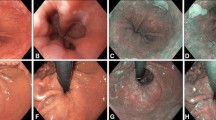Abstract
Background
We have shown that tension applied to the esophageal pouches in long-gap esophageal atresia allows primary repair without necessity for intestinal or gastric transposition.
Objective
To determine whether the mural structure of the upper esophageal pouch is altered by tension.
Materials and methods
We examined the esophagus with high-resolution endoscopic ultrasonography. The upper pouch was examined before traction and the upper and lower esophagus were examined after primary repair. Of 11 patients examined, 7 were male. At initial surgery the age, weight and length of the patients (mean ± SD) were 118 ± 88 days, 4.7 ± 1.2 kg and 54 ± 4 cm, respectively. The gap length was 4.7 ± 1.1 cm.
Results
The pretraction measurement of the muscularis propria of the upper pouch was similar to the postanastomotic measurement of the upper esophagus, and there was no statistically significant difference from the lower esophageal segments after anastomosis: 0.83 ± 0.19, 0.80 ± 0.15 and 0.81 ± 0.22 mm, respectively (P = 0.90). The thickness of combined mucosa and submucosa was also very similar in all three measurements, respectively: 0.93 (0.21) mm vs. 1.06 (0.08) mm vs. 1.0 (0.11) mm (P = 0.14).
Conclusion
The layers of the upper esophageal pouch are preserved in infants with esophageal atresia in whom esophageal length is increased with tension.


Similar content being viewed by others
References
Foker JE, Kendall TC, Catton K, et al (2005) A flexible approach to achieve a true primary repair for all infants with esophageal atresia. Semin Pediatr Surg 14:8–15
Foker J, Linden B, Boyle E, et al (1997) Development of a true primary repair for the full spectrum of esophageal atresia. Ann Surg 226:543–553
Skarsgard ED (2004) Dynamic esophageal lengthening for long gap esophageal atresia: experience with two cases. J Pediatr Surg 39:1712–1714
Lopes MF, Reis A, Coutinho S, et al (2004) Very long gap esophageal atresia successfully treated by esophageal lengthening using external traction sutures. J Pediatr Surg 39:1286–1287
Gaglione G, Tramontano A, Capobianco A, et al (2003) Foker’s technique in oesophageal atresia with double fistula: a case report. Eur J Pediatr Surg 3:50–53
Al-Qahtani AR, Yazbeck S, Rosen NG, et al (2003) Lengthening technique for long gap esophageal atresia and early anastomosis. J Pediatr Surg 38:737–739
Hasegawa N, Niwa Y, Arisawa T, et al (1996) Preoperative staging of superficial esophageal carcinoma: comparison of an ultrasound probe and standard endoscopic ultrasonography. Gastrointest Endosc 44:388–393
Fox VL, Nurko S, Teitelbaum JE, et al (2003) High-resolution EUS in children with eosinophilic “allergic” esophagitis. Gastrointest Endosc 57:30–36
Hirschl RB, Yardeni D, Oldham K, et al (2002) Gastric transposition for esophageal replacement in children: experience with 41 consecutive cases with special emphasis on esophageal atresia. Ann Surg 236:531–539
Lindahl H, Louhimo I (1987) Livaditis myotomy in long-gap esophageal atresia. J Pediatr Surg 22:109–112
Ricketts R, Luck S, Raffensperger J (1981) Circular esophagomyotomy for primary repair of long-gap esophageal atresia. J Pediatr Surg 16:365
Kimura K, Nishijima E, Tsugawa C, et al (2001) Multistaged extrathoracic esophageal elongation procedure for long gap esophageal atresia: experience with 12 patients. J Pediatr Surg 36:1725–1727
Lessin MS, Wesselhoeft CW, Luks FI, et al (1999) Primary repair of long-gap esophageal atresia by mobilization of the distal esophagus. Eur J Pediatr Surg 9:369–372
Lindahl H, Rintala R (1995) Long-term complications in cases of isolated esophageal atresia treated with esophageal anastomosis. J Pediatr Surg 30:1222–1223
Printz H, Schlenzka R, Requadt P, et al (1997) Small bowel lengthening by mechanical distraction. Digestion 58:240–248
Park J, Puapong DP, Wu BM, et al (2004) Enterogenesis by mechanical lengthening: morphology and function of the lengthened small intestine. J Pediatr Surg 39:1823–1827
Acknowledgements
The authors thank Rebecca Lai and Shaun Mallery for help during initial examination of US images.
Author information
Authors and Affiliations
Corresponding author
Rights and permissions
About this article
Cite this article
Khan, K.M., Foker, J.E. Use of high-resolution endoscopic ultrasonography to examine the effect of tension on the esophagus during primary repair of long-gap esophageal atresia. Pediatr Radiol 37, 41–45 (2007). https://doi.org/10.1007/s00247-006-0333-9
Received:
Revised:
Accepted:
Published:
Issue Date:
DOI: https://doi.org/10.1007/s00247-006-0333-9




